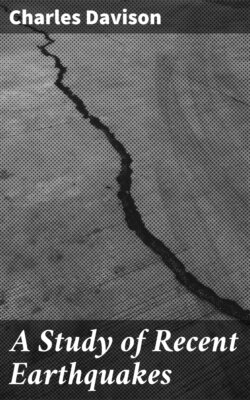A Study of Recent Earthquakes

Реклама. ООО «ЛитРес», ИНН: 7719571260.
Оглавление
Charles Davison. A Study of Recent Earthquakes
A Study of Recent Earthquakes
Table of Contents
PREFACE
A STUDY OF. RECENT EARTHQUAKES
CHAPTER I
INTRODUCTION
TERMS AND DEFINITIONS
ORIGIN OF EARTHQUAKES
FOOTNOTES:
CHAPTER II.ToC
THE NEAPOLITAN EARTHQUAKE OF DECEMBER 16TH, 1857
ISOSEISMAL LINES AND DISTURBED AREA
DAMAGE CAUSED BY THE EARTHQUAKE
GENERAL OBJECTS OF INVESTIGATION
POSITION OF THE EPICENTRE
DEPTH OF THE SEISMIC FOCUS
NATURE OF THE SHOCK
ELEMENTS OF THE WAVE-MOTION
SOUND-PHENOMENA
VELOCITY OF THE EARTH-WAVES
MINOR SHOCKS
ORIGIN OF THE EARTHQUAKE
FOOTNOTES:
CHAPTER III.ToC
THE ISCHIAN EARTHQUAKES OF MARCH 4TH, 1881, AND JULY 28TH, 1883
VOLCANIC HISTORY OF ISCHIA
EARTHQUAKE OF MARCH 4TH, 1881
ISOSEISMAL LINES AND DISTURBED AREA
POSITION OF THE EPICENTRE
DEPTH OF THE SEISMIC FOCUS
NATURE OF THE SHOCK
AFTER-SHOCKS
EARTHQUAKE OF JULY 28TH, 1883
PREPARATORY SIGNS
ISOSEISMAL LINES AND DISTURBED AREA
POSITION OF THE EPICENTRE
DEPTH OF THE SEISMIC FOCUS
NATURE OF THE SHOCK
LANDSLIPS
AFTER-SHOCKS
CHARACTERISTICS OF ISCHIAN EARTHQUAKES
ORIGIN OF THE ISCHIAN EARTHQUAKES
FOOTNOTES:
CHAPTER IV.ToC
THE ANDALUSIAN EARTHQUAKE OF DECEMBER 25TH, 1884
DAMAGE CAUSED BY THE EARTHQUAKE
ISOSEISMAL LINES AND DISTURBED AREA
THE UNFELT EARTHQUAKE
POSITION OF THE EPICENTRE
DEPTH OF THE SEISMIC FOCUS
NATURE OF THE SHOCK
SOUND-PHENOMENA
VELOCITY OF THE EARTH-WAVES
MISCELLANEOUS PHENOMENA
AFTER-SHOCKS
GEOLOGY OF THE MEIZOSEISMAL AREA AND ORIGIN OF THE EARTHQUAKES
REFERENCES
FOOTNOTES:
CHAPTER V.ToC
THE CHARLESTON EARTHQUAKE OF AUGUST 31ST, 1886
DAMAGE CAUSED BY THE EARTHQUAKE
ISOSEISMAL LINES AND DISTURBED AREA
PREPARATION FOR THE EARTHQUAKE
NATURE OF THE SHOCK
THE DOUBLE EPICENTRE
ORIGIN OF THE DOUBLE SHOCK
DEPTH OF THE SEISMIC FOCI
VELOCITY OF THE EARTH-WAVES
MISCELLANEOUS PHENOMENA
AFTER-SHOCKS
ORIGIN OF THE EARTHQUAKE
REFERENCES
FOOTNOTES:
CHAPTER VI.ToC
THE RIVIERA EARTHQUAKE OF FEBRUARY 23RD, 1887
DAMAGE CAUSED BY THE EARTHQUAKES
PREPARATION FOR THE EARTHQUAKES
ISOSEISMAL LINES AND DISTURBED AREA
POSITION OF THE EPICENTRES
DEPTH OF THE PRINCIPAL FOCUS
NATURE OF THE SHOCK
SOUND-PHENOMENA
THE UNFELT EARTHQUAKE
EFFECTS OF THE EARTHQUAKE AT SEA
MISCELLANEOUS PHENOMENA
AFTER-SHOCKS
ORIGIN OF THE EARTHQUAKES
REFERENCES
FOOTNOTES:
CHAPTER VII.ToC
THE JAPANESE EARTHQUAKE OF OCTOBER 28TH, 1891
THE MEIZOSEISMAL AREA
DAMAGE CAUSED BY THE EARTHQUAKE
ISOSEISMAL LINES AND DISTURBED AREA
NATURE OF THE SHOCK
PRINCIPAL MEASUREMENTS OBTAINED FROM SEISMOGRAPHIC RECORDS
VELOCITY OF THE EARTH-WAVES
THE GREAT FAULT-SCARP
MINOR SHOCKS
EFFECT OF THE EARTHQUAKE ON THE SEISMIC ACTIVITY OF THE ADJOINING DISTRICTS
ORIGIN OF THE EARTHQUAKE
REFERENCES
FOOTNOTES:
CHAPTER VIII.ToC
THE HEREFORD EARTHQUAKE OF DECEMBER 17TH, 1896, AND THE INVERNESS EARTHQUAKE OF SEPTEMBER 18TH, 1901
THE HEREFORD EARTHQUAKE OF DECEMBER 17TH, 1896
ISOSEISMAL LINES AND DISTURBED AREA
NATURE OF THE SHOCK
DIRECTION OF THE SHOCK
COSEISMAL LINES AND VELOCITY OF EARTH-WAVES
SOUND-PHENOMENA
MINOR EARTHQUAKES
ORIGIN OF THE EARTHQUAKES
THE INVERNESS EARTHQUAKE OF SEPTEMBER 18TH, 1901
PREPARATORY SHOCKS
EFFECTS OF THE SHOCK
ISOSEISMAL LINES AND DISTURBED AREA
NATURE OF THE SHOCK
SOUND-PHENOMENA
ORIGIN OF THE EARTHQUAKE
THE AFTER-SHOCKS AND THEIR ORIGIN
SYMPATHETIC EARTHQUAKES
CONCLUSION
REFERENCES
FOOTNOTES:
CHAPTER IX.ToC
THE INDIAN EARTHQUAKE OF JUNE 12TH, 1897
ISOSEISMAL LINES AND DISTURBED AREA
NATURE OF THE SHOCK
ELEMENTS OF THE WAVE-MOTION
SOUND-PHENOMENA
VELOCITY OF THE EARTH-WAVES
THE UNFELT EARTHQUAKE
EARTH-FISSURES, SAND-VENTS, ETC
LANDSLIPS
ROTATION OF PILLARS, ETC
AFTER-SHOCKS
STRUCTURAL CHANGES IN THE EPICENTRAL AREA
ORIGIN OF THE EARTHQUAKE
REFERENCES
FOOTNOTES:
CHAPTER X.ToC
CONCLUSION
FORE-SHOCKS
DISTURBED AREA
POSITION OF THE EPICENTRE
DEPTH OF THE SEISMIC FOCUS
NATURE OF THE SHOCK
SOUND-PHENOMENA
VELOCITY OF THE EARTH-WAVES
STRUCTURAL CHANGES IN THE EPICENTRAL AREA
AFTER-SHOCKS
ORIGIN OF EARTHQUAKES
FOOTNOTES:
INDEX.ToC
Отрывок из книги
Charles Davison
Published by Good Press, 2019
.....
The existence of the Montemurro focus must, however, complicate any relation that may connect these two quantities.
Maximum Velocity.—The means at Mallet's disposal for determining the maximum velocity were more numerous than those available for the amplitude. From the dimensions of a fallen column of regular form we should be able, he remarks, to find an inferior limit to the value of the maximum velocity; while a superior limit at the same place may be obtained from some other regular solid which escaped being overthrown. If a loose body is projected by the shock at a place where the angle of emergence is known, the horizontal and vertical distances traversed by the centre of gravity will give the velocity of projection. Or, if two such bodies are projected at one place, the same measures for each will as a rule give both the angle of emergence and the velocity of projection. A third method depends on the fissuring of walls, supposing that we know the force per unit surface which, when suddenly applied, is just sufficient to produce fracture. Sometimes more than one method must be applied to the same object. The two gate-pillars near Saponara (illustrated in Fig. 6) for example required a horizontal velocity of 5.48 feet per second to fracture them, and an additional velocity of 5.14 feet per second to overthrow them.
.....